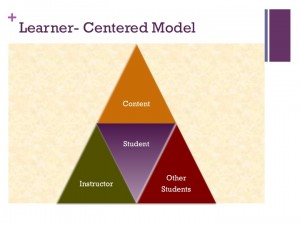In the field of online learning, there recently has been tremendous press coverage about MOOCs (massive open online courses). Almost weekly, articles are published that tout this innovation as the next great wave in online learning. Thousands of students at a time can have access to courses taught at the best universities in the world, by world-renowned professors. But even if the content is taught by the ‘best’ professors in their fields, what always is missing from these initial attempts to scale up teaching for the masses, is interactions with other learners. A core assumption regarding best practices in student-centered learning, is interaction with other students as per the chart below.
A new article in the September issue of “Stanford News” offers another way to do MOOCs that includes student groups and real-life projects. What is innovative about this new learning platform is that, despite the massive numbers of students, each can be teamed up with a small cohort of other students to solve real-life problems in an active learning context. Specifically, the model is noteworthy for the following:
- Experiential learning—The “learn by doing” approach has many advocates in constructivist circles. It is rooted on a problem-based learning (PBL) approach, which emphasizes small teams working together to solve real-life problems.
- Diverse groups–In this instance, algorithms were developed by Stanford researchers to select diverse groups of 8-10 students from over 150 countries. There is no way a traditional campus, even as diverse as those at CUNY, could ever produce this type of cultural melting pot of talents and life experiences.
- Flipped classroom—This is a hot topic in teaching circles, whereby course content is relegated to out-of- class videos and other materials, while in-class activities involve interactive and engaging group and other experiences. Stanford reported that students liked this format and were pleased with the overall learning in the course.
- Students learning from their peers—Although traditional instruction is more broadcast in nature, there is tremendous potential in students learning from their peers. Stanford’s Venture Lab was specifically designed for group learning.
“The most important part of the platform is that students can learn from their peers . . . The social and experiential aspects of learning must not be diminished by going online; on the contrary, the challenge is how to amplify them online.” (Quote from Amin Saberi, Venture Lab developer, see reference below.) - Improvements to platform—As with the first iteration of any technology, the Venture Lab platform will be improved and refined. Among the tools developers are looking to incorporate in the future are gaming and simulation technologies. This can only improve the learning experience for the many students enrolled in these courses.
Take-away
There is no doubt that this type of teaching is foreign to traditional institutions of higher education–on that point, we can all agree. A more important question is whether this type of learning is foreign to students of today. I think that “learning is learning” and that regardless of the modes or methods, what matters most is what we can gain from the experience as individuals. Learning is taking place for many of these students enrolling in Stanford’s MOOCs. If the goal of education is learning, then it behooves all institutions to take an honest and open approach when considering these innovations in teaching. To its credit, Stanford is leading the way for a new teaching and learning paradigm.
Sources:
Graphic: Learner Centered Model, created by Bruce Rosenbloom, 2012
“New Platform for Online Courses Stresses Team-based, Experiential Learning,” Stanford News, Sept. 17, 2012. Retrieved from: http://news.stanford.edu/news/2012/september/venture-lab-platform-091712.html?view=print




Pingback: Round Up! : Footenotes